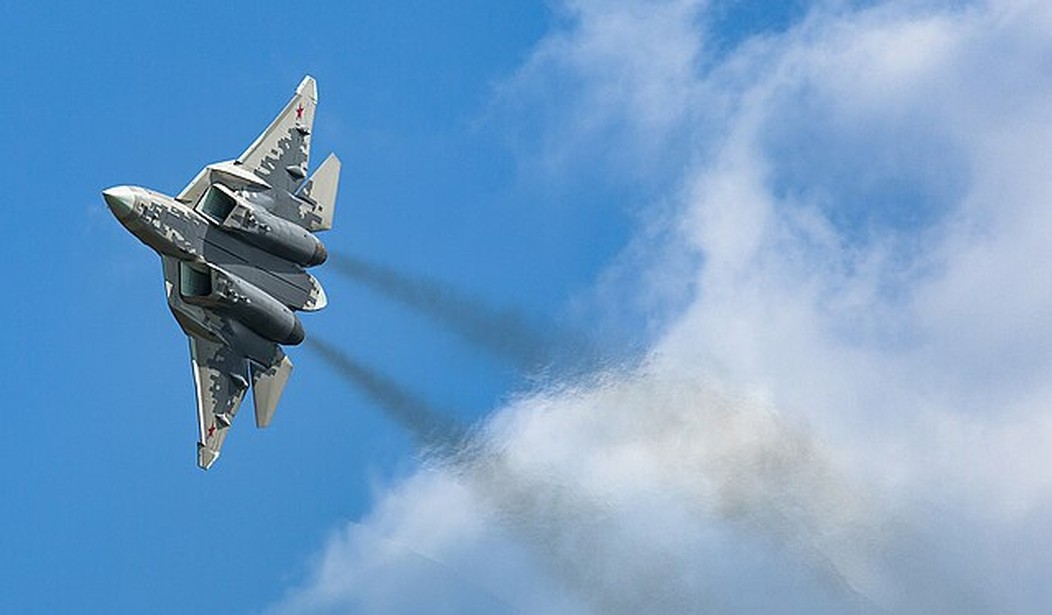Producing a new fighter jet is difficult, time-consuming, and always ends up costing too much. Don't even get me started on Lockheed-Martin's troubled F-35 Lightning II, which just resumed production after a year-long pause.
The Lightning's development problems are legendary, but after many delays and too much money, "Fat Amy" (as pilots call it) works. Lockheed has built more than 1,000 F-35s already, and customers are happy with it — including export buyers who weren't in on the fighter's lengthy development and weren't originally contracted to buy any. Nation-states with serious air defense needs seem to love Fat Amy.
Russia, on the other hand, is flying nowhere fast with its own stealth fighter, the oft-delayed Su-57 (NATO reporting name, "Felon"). Production of the 5th-generation stealth air superiority jet has reportedly been "all but crippled" by Western sanctions on Russia's technology sector, according to a report this week in the UK Telegraph.
"Sanctions put into place by Western governments in the 31 months since Russia widened its war on Ukraine have throttled the supply of this critical hardware," military analyst David Axe reported. "As a result, 'production of the Su-57 is in jeopardy,' Frontelligence Insight concluded."
"The delivery rate of new Su-57s has decreased sharply from 2023 to 2024," United24 reported on Wednesday, "a deviation from typical trends where delivery rates generally increase as production stabilizes."
But I wonder if sanctions tell the full story.
And Another Thing: Russia doesn't give its jets cool nicknames like Eagle or Falcon. So NATO assigns names to Russian/Soviet planes for easier communications. Bombers get B-names like Badger, Bear, and Backfire. Fighters get F-names like Felon, Fullback, and (for the 1950s-era MiG-15) Fagot. It was a more innocent time.
Despite sanctions, Russia has reportedly managed to expand (or at least continue) production of its well-regarded Su-34 and Su-35 4th-generation jets. Despite not being stealthy, both jets require high-tech components for their radars, avionics, and other systems.
If Felon production really has stalled, it might be because it's just no damn good.
And Another, Another Thing: Fourth-generation jets are highly maneuverable, carry deadly air-to-air and air-to-ground armaments, and have high-tech radars, but they are not stealthy. Fifth-generation jets are all that and more, plus they enjoy stealth properties. Sixth-generation jets don't yet exist, but the U.S. and China are working on them.
The Su-57 prototype first flew in 2010, 20 years after the F-22 Raptor stealth fighter it was meant to counter. So Russia started off way, way, way behind the eight-ball — and from there, things got worse.
Still, Sukhoi did manage to produce perhaps as many as two dozen Felons before Vlad Putin ordered the full-scale invasion of Ukraine in 2022. But they have been notably absent from combat. Some say that's because Moscow is holding its limited quantities of stealth fighters in reserve for a possible war against the West. But India dropped out of the Su-57 program in 2018 because "the plane’s Russian-designed combat avionics, radars, and sensors are not up to fifth-generation standards."
There's more to stealth than having a small radar cross-section — it's a whole set of technologies and operational doctrines. Russia likely can't risk its stealth fighters in Ukraine because they probably aren't all that stealthy.
If Western components are scarce, and you have to choose between proven jets like the Su-34/35 and unproven jets like the Su-57, which are you going to build?
Recommended: Oh, SNAP! Germany Has a New Way to Defend Yourself Against Machete-Wielding Migrants
P.S. Did you know that VIP Platinum members can message me — or any of your favorite PJ Media writers — directly? Join or upgrade today during our 60% off FIGHT promotion and let's start talking.










Join the conversation as a VIP Member